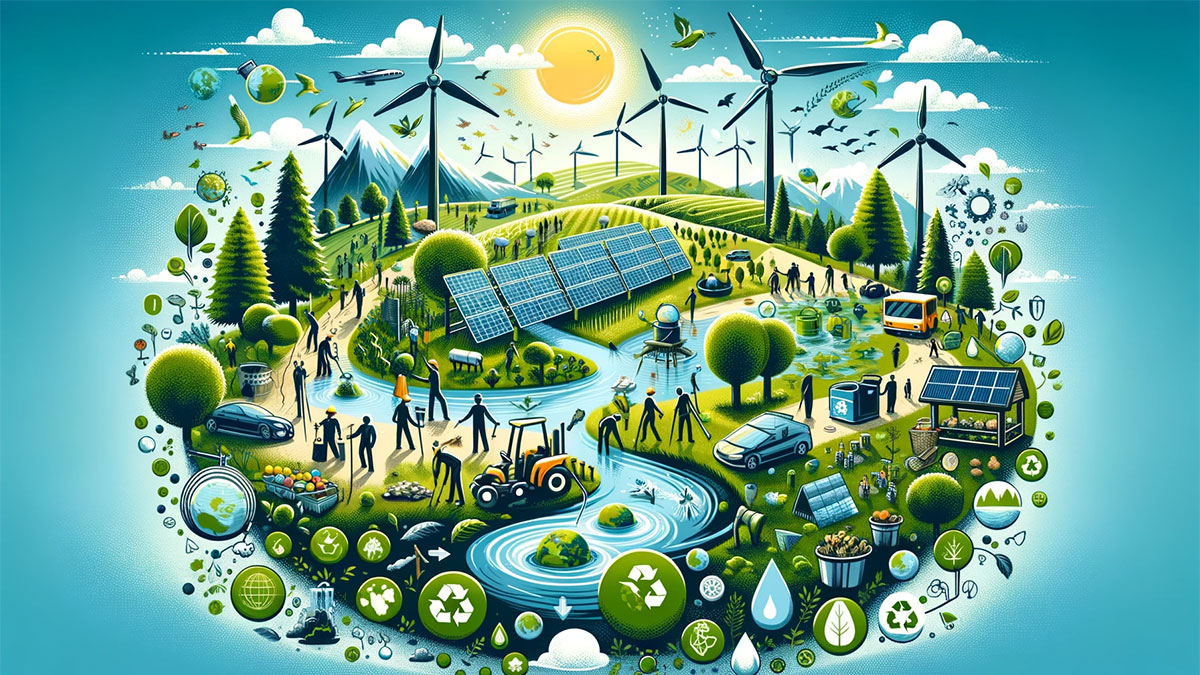As the global population grows and consumption patterns intensify, the strain on the planet’s natural resources is becoming increasingly evident. By 2050, several of these resources may reach critical levels of depletion. Here’s an overview of ten key resources, along with their current status and the level of concern regarding their availability by 2050.
| Resource | Sustainability Concern |
|---|---|
| Fresh Water | High |
| Fish Stocks | High |
| Rare Earth Elements | Moderate |
| Phosphorus | High |
| Oil | High |
| Natural Gas | Moderate |
| Coal | Low |
| Sand | Moderate |
| Helium | High |
| Forests | High |
What Natural Resources Could Run Out by 2050?
By 2050, several critical natural resources are at risk of severe depletion. While no one can know the future, the situation is driven by factors like population growth, industrial activities, and environmental challenges. Key resources facing scarcity include fresh water, fish stocks, rare earth elements, and others essential for survival and modern living.
The potential depletion of these resources poses significant economic, environmental, and social concerns, highlighting the urgent need for sustainable management and conservation efforts.
1. FreshWater
Sustainability Concern: High
Fresh water is vital for human survival, agriculture, and industry. In 2023, water scarcity is already a reality in many parts of the world, driven by factors like climate change, pollution, and overuse. Aquifers are being depleted faster than they can replenish, and rivers and lakes are drying up or becoming too polluted for use. By 2050, it is estimated that a significant portion of the global population will be living in water-stressed areas, making the conservation and efficient use of freshwater a critical issue.
The challenge extends beyond just availability. Water quality issues, driven by pollution and inadequate treatment facilities, compound the crisis. Addressing these issues requires a multifaceted approach, including improved water management, investment in treatment technologies, and a global commitment to reducing pollution.
2. Fish Stocks
Sustainability Concern: High
The state of the world’s fish stocks is alarming in 2023. Overfishing, habitat destruction, and climate change have led to a significant decline in many species. Some estimates suggest that if current fishing practices continue, the majority of the world’s fisheries could collapse by 2050. This not only affects the biodiversity of our oceans but also the livelihoods of millions of people who depend on fishing for food and income.
Efforts to manage fish stocks sustainably are in place, but enforcement and compliance remain challenging. Marine protected areas, quotas, and responsible fishing practices are critical to ensuring the long-term sustainability of fish stocks. Consumer awareness and demand for sustainably sourced seafood can also drive positive change in the industry.
3. Rare Earth Elements
Rare earth elements are essential in the manufacturing of high-tech devices, renewable energy technologies, and military equipment. As of 2023, the extraction and processing of these elements are concentrated in a few countries, leading to geopolitical and supply chain concerns. The rarity and difficulty in extracting these elements, combined with growing demand, suggest that we may face moderate shortages or increased prices by 2050.
Recycling and finding alternative materials are part of the solution. Efforts are underway to develop more sustainable extraction methods and reduce dependence on these critical materials by innovating in product design and material science.
4. Phosphorus
Sustainability Concern: High
Phosphorus is a key ingredient in fertilizers and is essential for global food production. The primary source of phosphorus is phosphate rock, a non-renewable resource. In 2023, there are concerns about both the depletion of high-quality phosphate reserves and the geopolitical concentration of these reserves. By 2050, the demand for phosphorus could significantly outstrip supply, potentially leading to a global food security crisis.
Alternative sources of phosphorus, such as recycling from waste streams and developing more efficient fertilization techniques, are crucial. Additionally, research into genetically modified crops that require less phosphorus could also help mitigate this looming crisis.
5. Oil
Sustainability Concern: High
In 2023, oil remains a fundamental part of the global energy mix, but its future is fraught with challenges. Existing reserves are being depleted, and new discoveries are becoming rarer and more difficult to exploit. Environmental concerns and the transition to renewable energy are also influencing the industry. By 2050, we may face significant oil shortages, particularly if alternative energy sources do not scale up rapidly enough.
The transition to renewable energy sources like solar, wind, and biofuels is essential. Additionally, improving energy efficiency in transportation, industry, and buildings can reduce dependence on oil.

6. Natural Gas
Natural gas is often touted as a cleaner alternative to coal and oil, but it is still a finite fossil fuel. In 2023, the use of natural gas is widespread, especially for electricity generation and heating. While current reserves are substantial, the increasing demand and potential geopolitical issues could lead to moderate supply challenges by 2050.
Investment in renewable energy sources and energy efficiency, along with the development of biogas and other sustainable alternatives, can help reduce reliance on natural gas.
7. Coal
Coal is the most abundant fossil fuel, and in 2023, it will continue to be a major energy source, particularly in developing countries. However, due to environmental concerns and the global shift towards cleaner energy sources, the future of coal is uncertain. By 2050, coal may still be available, but its usage could be significantly reduced due to policy shifts and technological advancements in renewable energy.
The key to managing coal’s impact is through the continued transition to renewable energy sources and the implementation of carbon capture and storage technologies for existing coal-powered plants.
8. Sand
Sand, especially the type used in construction, is in surprisingly high demand. In 2023, excessive mining of riverbeds and beaches for sand is causing environmental degradation. While sand is abundant, the specific types needed for concrete and other construction materials are becoming scarce in some regions. By 2050, this could lead to moderate shortages and environmental challenges.
Sustainable mining practices, along with the development of alternative construction materials, are critical in addressing this issue.
9. Helium
Sustainability Concern: High
Helium is a non-renewable resource with unique properties, used in medical imaging, scientific research, and as a coolant in various applications. In 2023, helium reserves are being depleted rapidly, and there are concerns about its availability in the future. By 2050, we could face significant shortages, impacting industries and research that rely on this gas.
Efforts to recycle helium, along with the exploration for new reserves and the development of alternative technologies, are necessary to manage this potential crisis.
10. Forests
Sustainability Concern: High
Forests are essential for biodiversity, climate regulation, and resources like wood and medicinal plants. In 2023, deforestation is a major concern, driven by agriculture, logging, and urban expansion. The loss of forests not only impacts wildlife and local communities but also contributes to climate change. By 2050, the continued loss of forests could have severe environmental and social consequences.
Sustainable forestry practices, reforestation efforts, and policies aimed at reducing deforestation are key to preserving the world’s forests for future generations.
Strategies for Sustainability: Human Efforts to Preserve Resources
As we face the daunting prospect of critical resource depletion by 2050, human ingenuity and action play a pivotal role in altering this trajectory. There are several strategies and initiatives, both underway and proposed, that are crucial in this battle for sustainability.
1. Promoting Conservation and Efficient Use
- Water Conservation Measures: Implementing technologies for water recycling and rainwater harvesting, and promoting water-saving practices among individuals and industries.
- Sustainable Fishing Practices: Enforcing stricter fishing quotas and supporting aquaculture to reduce the pressure on wild fish populations.
2. Advancing Technology and Innovation
- Developing Alternative Materials: Researching substitutes for rare earth elements and exploring synthetic alternatives for phosphorus in fertilizers.
- Enhancing Renewable Energy Use: Accelerating the shift from fossil fuels to renewable energy sources like solar, wind, and geothermal.
3. Policy and Global Cooperation
- Implementing Environmental Regulations: Governments enforcing stricter regulations on resource extraction and usage to minimize environmental impact.
- Fostering International Collaboration: Global partnerships to manage shared resources, like international water bodies and fish stocks.
4. Raising Awareness and Education
- Informing the public about the importance of resource conservation.
- Encouraging sustainable consumer choices and lifestyles.
5. Investing in Research and Development
- Exploring New Extraction Methods: Innovating less invasive methods of extracting resources like sand and coal.
- Developing Efficient Recycling Systems: For resources like helium, creating effective systems to recycle and reuse.
Key Sustainability Initiatives
| Resource | Sustainability Initiative |
|---|---|
| Fresh Water | Water recycling technologies, conservation campaigns |
| Fish Stocks | Sustainable fishing quotas, aquaculture development |
| Rare Earth Elements | Alternative material research, recycling |
| Phosphorus | Synthetic fertilizer alternatives, efficient usage |
| Fossil Fuels | Renewable energy transition, energy efficiency improvements |
| Sand | Sustainable extraction methods, alternative materials |
| Helium | Recycling programs, new reserve exploration |
| Forests | Reforestation, sustainable forestry practices |
Summary
The path to preserving our natural resources by 2050 is multifaceted, involving a combination of technological innovation, policy reform, global cooperation, and individual action.
While the challenges are significant, the collective efforts of humanity offer a beacon of hope. By adopting and advancing these strategies, we can work towards a more sustainable and resource-secure future.

